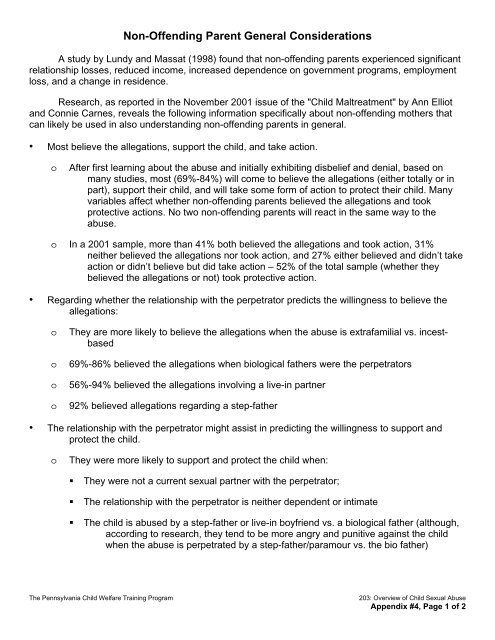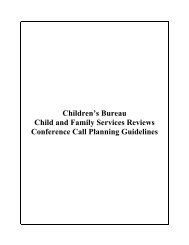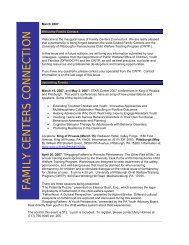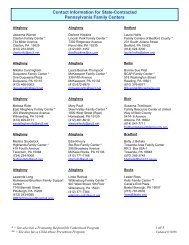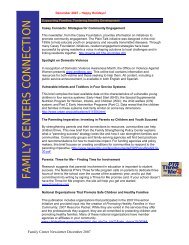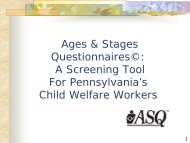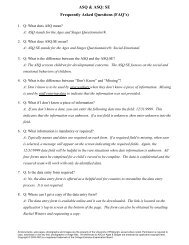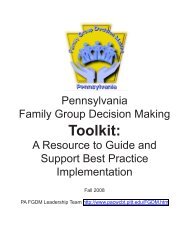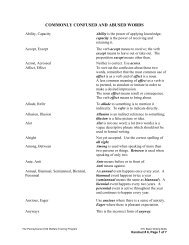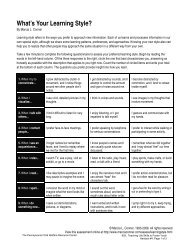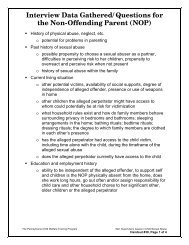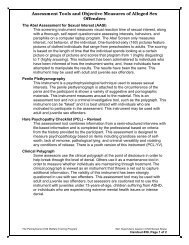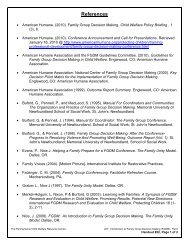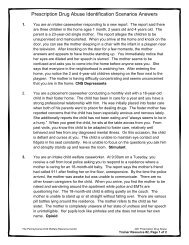Non-Offending Parent General Considerations - Pennsylvania Child ...
Non-Offending Parent General Considerations - Pennsylvania Child ...
Non-Offending Parent General Considerations - Pennsylvania Child ...
Create successful ePaper yourself
Turn your PDF publications into a flip-book with our unique Google optimized e-Paper software.
<strong>Non</strong>-<strong>Offending</strong> <strong>Parent</strong> <strong>General</strong> <strong>Considerations</strong><br />
A study by Lundy and Massat (1998) found that non-offending parents experienced significant<br />
relationship losses, reduced income, increased dependence on government programs, employment<br />
loss, and a change in residence.<br />
Research, as reported in the November 2001 issue of the "<strong>Child</strong> Maltreatment" by Ann Elliot<br />
and Connie Carnes, reveals the following information specifically about non-offending mothers that<br />
can likely be used in also understanding non-offending parents in general.<br />
• Most believe the allegations, support the child, and take action.<br />
o<br />
After first learning about the abuse and initially exhibiting disbelief and denial, based on<br />
many studies, most (69%-84%) will come to believe the allegations (either totally or in<br />
part), support their child, and will take some form of action to protect their child. Many<br />
variables affect whether non-offending parents believed the allegations and took<br />
protective actions. No two non-offending parents will react in the same way to the<br />
abuse.<br />
o In a 2001 sample, more than 41% both believed the allegations and took action, 31%<br />
neither believed the allegations nor took action, and 27% either believed and didn’t take<br />
action or didn’t believe but did take action – 52% of the total sample (whether they<br />
believed the allegations or not) took protective action.<br />
• Regarding whether the relationship with the perpetrator predicts the willingness to believe the<br />
allegations:<br />
o<br />
o<br />
o<br />
o<br />
They are more likely to believe the allegations when the abuse is extrafamilial vs. incestbased<br />
69%-86% believed the allegations when biological fathers were the perpetrators<br />
56%-94% believed the allegations involving a live-in partner<br />
92% believed allegations regarding a step-father<br />
• The relationship with the perpetrator might assist in predicting the willingness to support and<br />
protect the child.<br />
o<br />
They were more likely to support and protect the child when:<br />
• They were not a current sexual partner with the perpetrator;<br />
• The relationship with the perpetrator is neither dependent or intimate<br />
• The child is abused by a step-father or live-in boyfriend vs. a biological father (although,<br />
according to research, they tend to be more angry and punitive against the child<br />
when the abuse is perpetrated by a step-father/paramour vs. the bio father)<br />
The <strong>Pennsylvania</strong> <strong>Child</strong> Welfare Training Program<br />
203: Overview of <strong>Child</strong> Sexual Abuse<br />
Appendix #4, Page 1 of 2
<strong>Non</strong>-<strong>Offending</strong> <strong>Parent</strong> <strong>General</strong> <strong>Considerations</strong><br />
• The history of physical or sexual abuse has little to no affect on whether they are less or more<br />
likely to believe the allegations, support, and protect the child. However, substance abuse<br />
and social isolation did appear to affect willingness to believe daughters.<br />
• The age of the child might affect willingness to support and protect the child.<br />
o<br />
They were more likely to support and protect younger children – although some research<br />
notes that the age of the child did not matter when other factors were considered.<br />
• Gender of the child might affect willingness to support and protect the child.<br />
o<br />
<strong>Non</strong>-offending mothers were more likely to support and protect the child when the child is<br />
male – although some research notes that the gender of the child did not matter when<br />
other factors were considered. Males were twice as likely to be believed when<br />
compared to daughters – although males had significantly less support from fathers and<br />
sisters.<br />
• A small percentage of non-offending parents know about the abuse and tolerate it. These<br />
individuals might have a mental illness or believe that sexual abuse is a normal part of<br />
childhood.<br />
The <strong>Pennsylvania</strong> <strong>Child</strong> Welfare Training Program<br />
203: Overview of <strong>Child</strong> Sexual Abuse<br />
Appendix #4, Page 2 of 2


